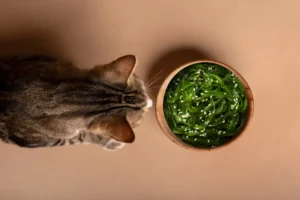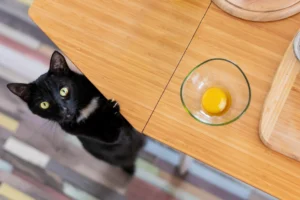Disclaimer: Always check with your vet on what “human foods” your cat can and cannot eat as information may vary based on their dietary needs and health conditions.
Mangos are a delicious fruit full of vitamins and minerals. A frozen cube of mango even sounds like a delicious cooling treat for our pet. But as obligate carnivorous, should cats be eating mangos?
Read on to learn more about why mangos could be good for cats, how much should they be eating and more.
Table of Contents
Is mango good for cats?
Mango can be a safe treat for cats in small amounts, but it’s not necessarily “good” for them in the same way it is for humans.
Nutritional Benefits
Mango contains vitamins A, C, and E, as well as some fibre, which can be beneficial. However, cats are obligate carnivores, meaning their primary nutritional needs come from meat, so they don’t require fruits like mango in their diet.
Moderation is Key
While mango is safe in small quantities, it should only be an occasional treat. Too much fruit can lead to digestive issues like diarrhoea.
Hydration
Mango has a high water content, which can help with hydration, but cats should primarily get their hydration from water.
Overall, while mango isn’t harmful, it should be offered sparingly and not as a replacement for a balanced cat diet.
Is mango bad for cats?
Although mangos do not provide any additional nutrition for their carnivorous dietary needs, mango is not bad for cats. But here are some pointers if you’re thinking whether to let your cat try some mango:
Digestive upset
Some cats may have sensitive stomachs, and eating mango could lead to digestive upset, such as diarrhoea or vomiting, especially if they consume too much.
Potential allergies
Some cats may have sensitivities or allergies to certain foods, including fruits, so it's important to monitor for any adverse reactions when introducing mango.
Individual reactions
While many cats may enjoy the taste of mango, not all will. It's essential to introduce any new food slowly and watch for any adverse reactions.
In summary, mango isn’t inherently bad for cats when given in moderation, but it shouldn’t be a staple in their diet. If you have any concerns, it’s best to consult your veterinarian.
How much mango can a cat eat?
Even though mangos can be a sweet and hydrating treat for your cat, they should only be given in small portions with the pit removed. A general rule of thumb is that treats should not exceed 10% of their total daily caloric intake.
Here’s a general guideline for feeding your cat mangos, but always speak to your vet before doing this as they can help you determine its suitability and amount based on your cat’s age, size and overall health.
Small cats (up to 5 kg or 11 lbs)
A small piece of mango, about 1/4 to 1/2 teaspoon.
Medium cats (5 to 7 kg or 11 to 15 lbs)
About 1/2 to 1 teaspoon of mango.
Large cats (over 7 kg or 15 lbs)
Up to/around 1 teaspoon of mango.
How to tell when a cat has had too much mango?
If your cat has eaten too much mango (or fruit), they may show some digestive symptoms or other signs of discomfort. Here’s what to watch for:
- Digestive upset: Diarrhoea, loose stools or vomiting
- Lethargy: Your cat seems more tired than usual if their stomach is bothering them
- Reduced appetite: They might avoid food (even their favourite treats) if they’re feeling bloated or nauseous
- Excessive drooling: This can happen if they feel queasy
- Dehydration: They might lose fluids from diarrhoea or vomiting, so watch for signs of dehydration, like dry gums or reduced skin elasticity.
If your cat shows any of these signs, keep them hydrated and avoid offering any more mango or treats for a day or two. If symptoms are severe or don’t resolve within 24 hours, it’s best to consult your vet for advice.
How often can cats eat mango?
Cats can enjoy mango as an occasional treat, ideally no more than once or twice a month. Since cats are obligate carnivores, their digestive systems aren’t designed to process fruits regularly. Here are some tips for offering mango in moderation:
- Limit treats to 10% of total diet: Treats, including mango, should make up no more than 10% of their total daily calories.
- Balance variety: If your cat enjoys other safe treats, consider rotating them to avoid offering mango too frequently.
If your cat seems to tolerate mango well, giving them a small amount occasionally is a nice way to add variety—just remember to keep the portions small and infrequent.
How to feed your cat mango?
Follow these steps to help ensure mangos are a safe, enjoyable snack for your cat:
Wash and peel:
Wash the mango thoroughly and remove the skin, which can be tough for cats to digest.
Remove the pit
The mango pit is a choking hazard and should be completely removed.
Cut into tiny pieces
Slice a small amount of the mango flesh into very tiny, bite-sized pieces that are easy for your cat to chew.
Introduce slowly
Offer just one small piece at first, especially if this is your cat’s first time trying mango. Watch for any reactions or signs of digestive upset.
Serve as a treat:
Avoid mixing mango with their regular food. Serve it as a treat on its own to prevent overeating and to monitor for reactions.
Limit frequency
Remember to only offer mango as an occasional treat, once or twice a month at most.











